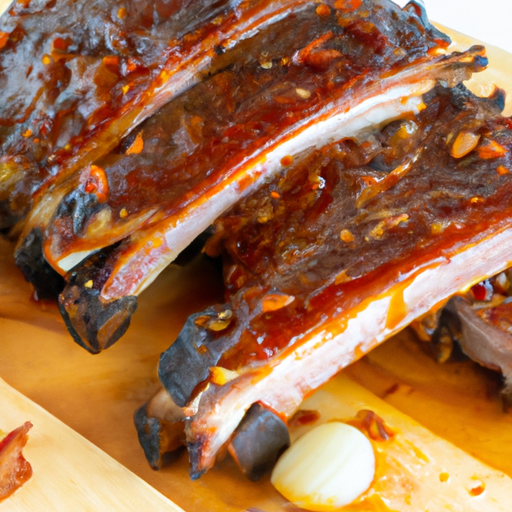Discovering the Amazing World of Baby Back Loin Ribs
If you’re a meat lover, chances are you’ve indulged in the succulent delight of baby back loin ribs. These tender and flavorful ribs have become a sensation in the world of barbecue and grilling. In this blog post, we will dive deep into the tantalizing world of baby back loin ribs, exploring their taste, common uses in cooking, nutritional value, and uncovering some interesting history and facts about this beloved cut of meat.
Taste and Texture That Takes You to Heaven
One of the reasons baby back loin ribs have gained such popularity is their incredible taste. These ribs are known for their tender and juicy meat that falls right off the bone. When properly cooked, they boast an irresistible balance of smoky, sweet, and savory flavors that will leave you craving more. The combination of rich marbling and intricate bone structure adds an extra layer of mouthwatering complexity, making each bite an unforgettable experience.
Versatility at Its Finest
Baby back loin ribs are incredibly versatile when it comes to cooking methods. While they are most commonly associated with barbecue and grilling, they can be prepared using various techniques such as smoking, baking, and even slow cooking. This makes them an excellent choice for any occasion, whether it’s a backyard gathering or a casual weeknight dinner.
Common Uses in Cooking
When it comes to cooking, baby back loin ribs are the star of the show for many barbecue enthusiasts. They are typically seasoned with a dry rub, marinade, or barbecue sauce, enhancing the natural flavors of the meat. Whether you prefer a classic Kansas City-style sauce or a tangy Carolina vinegar-based marinade, baby back loin ribs can handle it all. They can be enjoyed as a main course, paired with classic side dishes like cornbread, coleslaw, or mac and cheese, or even incorporated into other dishes like tacos or sliders.
Nutritional Value
While baby back loin ribs may be a treat for your taste buds, they also offer some nutritional benefits. They are an excellent source of protein, which is essential for muscle growth and overall health. Additionally, they contain important vitamins and minerals such as iron and zinc. However, it’s worth noting that baby back loin ribs are relatively high in fat, so it’s important to enjoy them in moderation as part of a balanced diet.
A Rich History and Fun Facts
Baby back loin ribs have a rich history that dates back to the early 19th century. They derive their name from the fact that they come from the upper part of the animal’s ribcage, close to the loin. Traditionally, these ribs were considered a byproduct of pork loin processing but soon gained popularity due to their unmatched tenderness and flavor.
Interestingly, baby back loin ribs are often mistakenly referred to as “baby back ribs.” However, the term “baby” actually refers to their smaller size in comparison to spare ribs. These ribs are cut from the back of the pig, close to the spine, which results in their delightful tenderness.
In Summary
Baby back loin ribs are a true delight for any meat lover. Their tender meat, exceptional taste, and versatility in cooking methods make them a favorite for barbecue enthusiasts around the world. Whether you’re enjoying them at a summer cookout or experimenting with different flavors, baby back loin ribs are a guaranteed crowd-pleaser. And now, armed with a deeper understanding of their culinary magic, you can fully savor every moment spent indulging in these delectable ribs. So fire up the grill, gather your loved ones, and let the baby back loin ribs take you on a mouthwatering journey you won’t soon forget!
Baby Back Loin Ribs
Origin: Baby back loin ribs are derived from the back area of a pig. They are called “baby back” because they are shorter in length compared to spare ribs. Baby back loin ribs are popular in American cuisine and are often associated with barbecue.
Common Uses: Baby back loin ribs are frequently grilled or smoked, and are commonly prepared with a dry rub or marinated for added flavor. They are often served with barbecue sauce and are a staple at backyard barbecues and summer cookouts.
Nutritional Benefits: Baby back loin ribs are a source of high-quality protein, essential amino acids, and several vitamins and minerals. However, they are also high in fat and calories. Depending on the cooking method and ingredients used, calorie and fat content can vary.
Unique Properties: Baby back loin ribs are known for their tenderness and delicious flavor. They have a higher meat-to-bone ratio compared to spare ribs, which makes them easier to eat. The meat on baby back loin ribs is typically leaner and more tender than other rib cuts.
Historical Significance: Ribs have a long history in various cuisines around the world. Baby back loin ribs gained popularity in the United States in the mid-20th century with the rise of barbecue culture. They became a favorite cut for barbecue enthusiasts due to their tenderness and versatility. Today, baby back loin ribs are enjoyed as a classic barbecue dish in many regions.




Use the share button below if you liked it.
It makes me smile, when I see it.